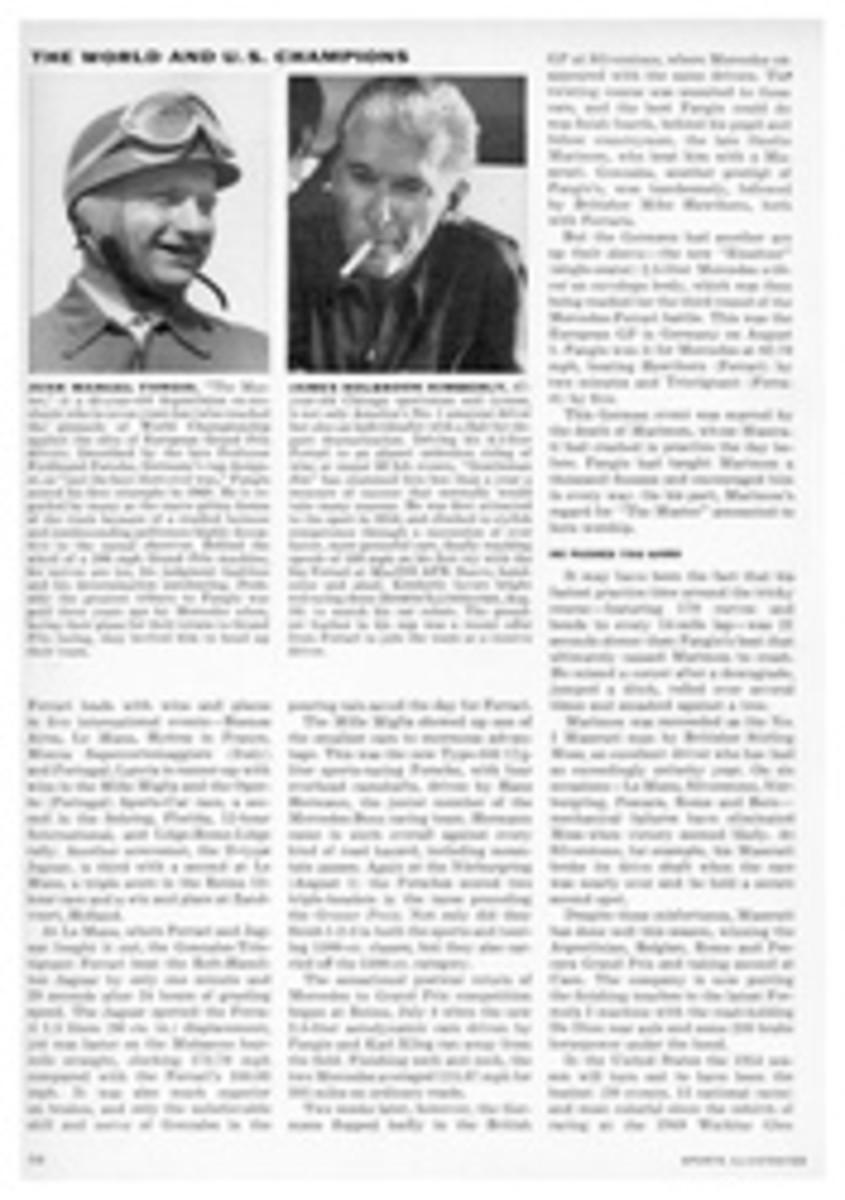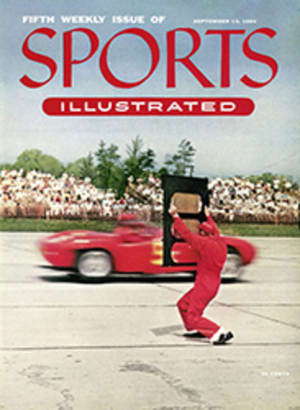
CHARLES vs. MARCIANO
The second episode in a 55 world series will be fought out in Yankee Stadium next Wednesday night but there will be only one man on each team and no bat will be in evidence although the features of the contestants may look as if they had been worked over with one before the world's championship is decided.
It is champion Rocky Marciano and ex-champion and No. 1 contender Ezzard Charles in a rematch for the heavyweight supremacy of the civilized world, if you call civilized what Marciano and Charles did to each other in their primitive, bloodied 15-round struggle three months ago. That night Charles sleep-walked back to his dressing-room resembling a man who had argued with and lost to the Super Chief and Marciano pushed his way back to his quarters with a close but justified decision and a torn left-eye that had to be sewn together like a sock with a three-inch rip.
Studying the contestants at their training camps in the Catskills a few days ago, I saw them as the alpha and zeta of physical contrast. On the scales it will be a stand-off, each one tipping a fraction this or that side of 187. There similarity ends. Charles is drawn fine, as if by an artist with a sense of aesthetic proportion, with smooth-muscled shoulders and tapering legs. The skin on his body is as tight as that of a drum and he is so graceful that he seems ready to take his place with Sugar Ray Robinson and the Mambo Kid Gavilan as Fistiana's gift to terpsichore.
No one will ever associate the rhythm of the dance with the heavy-footed, lumberingly powerful champion. He has weight-lifter's legs and thick, stubby arms. His moves are clumsy and awkward but purposeful. His flesh seems thick where Charles' is taut, and loose where the challenger's is tight. Looking at Rocky's back as he sat relaxed and freely sweating on a rubbing table after going five rounds with his sparring partners and twice that many with the newsreel cameras, you were reminded of the thick hard fat covering a slab of country-smoked bacon.
But musculature, as my medical friends must call it, will hardly decide the pattern of the fight. Boxing is still a contest of skills and wills and the secret of next Wednesday night lies not in the tibialis anterior or the sternocleidomastoid (to try one on for size) but in the brain reflexes, the battle plan, the mind-over-matter determination of these two contrasting but equally well-conditioned athletes. The natures of both men as well as their muscular development govern their styles.
Ezzard was a proud, stylish, self-contained, not quite arrogant figure presiding over the training table. When we talked about books—for it is a notorious, Tunneyish fact that he reads—he said sternly, "I've put books aside. They could distract me from what I'm doing. A prize fighter has to be crude and tough—crude and tough." He seemed to-savor the sound of it. Then he showed his regular, white-as-a-tooth-paste-ad teeth in a revealing grin. What he meant is he's been accused of being a Ferdinand of the prize ring and now he means to prove—if any proof is wanted off the last one—that he is ready to concentrate all of his knowledge and courage and coordination into an all-stops-out effort to become the first ex-champion ever to fight his way back to the top of the mountain.
Rocky doesn't need to talk himself into concentration. He doesn't need to shift mental gears to step himself up to his top fighting speed. He is, as Scott Fitzgerald would have said, a natural, and while he is as warm-hearted and gentle and ingratiating a young man as ever you want to meet, he is out to prove next Wednesday night that he was ring-rusty in June and that in his thick hands and short, chunky arms he has the power to knock out the best-conditioned and far away the best man he ever fought.
PHOTO ILLUSTRATION
1
5
11
4
12
21
17
27
16
24
23
22
26
34
35
36
37
38
32
43
44
PHOTO ILLUSTRATION
2
3
6
7
10
12
15
17
19
20
22
26
28
34
35
36
37
38
43
44
1
5
8
11
4
9
13
15
24
23
22
20
27
25
28
29
31
33
37
32
23
39
40
42
48
TWO PHOTOS
THE MUSCLES
l. Frontal (M. frontalis)
2. Orbicular muscle of eye (M. orbicularis oculi)
3. Zygomatic (M. zygomaticus)
4. Orbicular muscle of mouth (M. orbicularis oris)
5. Nasal (M. nasalis)
6. Masseter (M. masseter)
7. Risorius (M. risorius)
8. Cheek (M. buccinator)
9. Flat (M. platysma)
10. Sternocleidomastoid (M. sternocleidomastoideus)
11. Trapezius (M. trapezius)
12. Deltoid (M. deltoideus)
13. Greater pectoral (M. pectoralis major)
14. Triceps (M. triceps brachii)
15. Biceps (M. biceps brachii)
16. Brachial (M. brachialis)
17. Brachioradical (M. brachioradialis)
18. Long radial extensor muscle of wrist (M. extensor carpi radialis longus)
19. Common extensor muscle of fingers (M. extensor digitorum communis)
20. Ulnar extensor muscle of wrist (M. extensor carpi ulnaris)
21. Coraco-brachial (M. coracobrachialis)
22. Ulnar flexor muscle of wrist (M. flexor carpi ulnaris)
23. Long palmer (M. palmaris longus)
24. Radial flexor (M. flexor carpi radialis)
25. Rectus (M. rectus abdominis)
26. External oblique (M. obliquus abdominis externus)
27. Serratus magnus (M. serratus anterior)
28. Middle gluteal (M. gluteus medius)
29. Tensor muscle of broad fasciae (M. tensor fasciae latae)
30. Lateral great (M. vastus lateralis)
31. Straight head (M. rectus femoris)
32. Middle great (M. vastus medialis)
33. Tailor (M. sartorius)
34. Iliac (M. iliacus)
35. Greater psoas (M. psoas major)
36. Pectineus (M. pectineus)
37. Long adductor (M. adductor longus)
38. Slender (M. gracilis)
39. Anterior tibial (M. tibialis anterior)
40. Long extensor muscle of toes (M. extensor digitorum longus)
41. Long extensor muscle of great toe (M. extensor hallucis longus)
42. Long peroneal (M. peroneus longus)
43. Gastrocnemius (M. gastrocnemius)
44. Soleus (M. soleus).
DR. PECK SAYS:
Although both Rocky Marciano and Ezzard Charles have splendid all-over muscular development, each has one area in which his musculature is outstanding. In the case of Rocky it is in his phenomenally developed thigh and leg muscles and in the case of Ezzard in his shoulder and arm muscles. Although I have not observed either boxer in an actual fight, their characteristic musculature should influence their styles. Since Rocky's powerful thigh and leg muscles exert a downward thrust against the ground, his most effective blow should be a short, upward one—like the recoil of a gun. Charles, contrarily, should find blows straight from the shoulder or chest most useful. Marciano's arms are unusually short, but his disadvantage in reach is offset by the great speed that characterizes all short, well-developed muscles. If the fight were held in a swimming pool, with both boxers treading water, Rocky wouldn't be able to hit very hard. Charles would. On the dry canvas at Yankee Stadium I suspect Marciano will have a distinct advantage.

